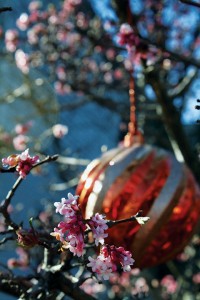If the unusually warm weather brought you outdoors during the days around this Christmas and New Year’s, either in your own yard or walking up the sidewalk, you may have noticed a myriad of curious sights: green, green grass; hearty winter viburnum and cherry trees blossoming; Johnny-Jump Ups and daffodils pushing up through the ground; and lavender lilacs in bloom. Even some rhododendrons and azaleas flowered while still strung with Christmas lights, an unusual juxtaposition.
In the dead of winter, nature was coming into life in the Tri-Town region – and beyond. Christmas Day temperatures reached the lower 60s, preceded and followed by days of spring-like 50-degree weather.
Take this week’s cover of The Wanderer, for example. Although viburnum is known to bloom throughout autumn, this particularly warm fall, followed by an above-average mild December, kept some of these trees from reaching total dormancy and to reawaken instead to bloom out another round of flowers into the New Year. A series of cold days and biting frosts will eventually render the viburnum dormant; however, other types of flowering vegetation such as the cherry tree, sweetbay magnolia, and the lilac operate on an energy budget of sorts, and the warmer weather has caused some of these trees to expend too much energy too early in the growing season.
It is not entirely uncommon anymore for fall-flowering trees to perpetuate their bloom into the winter, said local arborist Paul Sellers, who is also the senior arborist for Eversource, but how quickly it turns cold and how cold it becomes will determine how the trees will perform in springtime.
“Generally, when we experience a warm fall season, like we did this year, plants start to flower prematurely,” said Sellers during a phone interview. “Generally, it’s not a full bloom that you get. Rather, a limited bloom happens.”
When the temperatures change, Sellers said, the cold kills off the foliage of the prematurely blossoming trees.
The result is fewer blooms in the spring.
One may wonder if is there anything that can be done to save the trees so they will still burst with blooms in the spring. Yes and no, said Sellers.
“Mulching is actually one of the best buffers for keeping the root system safe and secure,” Sellers said, “even through the winter months.”
It keeps the important root zone moist, which could help prevent further desiccation and vulnerability to root damage causing more of a negative impact next spring on blooming trees.
If you want to try to take action to help your trees after an early bloom, Sellers said it is still not too late to mulch around your trees and gardens, but hold off on using fertilizer until you have the soil analyzed by a professional.
“If you over fertilize, you can actually do more harm than good,” said Sellers. “It is worthwhile to have the soil testing done, and it’s best to have a professional do the assessment.”
The National Oceanic and Atmospheric Administration (NOAA) deemed this December to be the warmest on record. Just about 12,000 daily warm temperature records were broken this month from the plains east to the coast where warm weather records were figuratively shattered. Furthermore, climatologists expect that NOAA, in 2016, will report the year 2015 as the warmest year globally ever recorded.
A record warm for Mattapoisett, Marion, and Rochester doesn’t attract a whole lot of climate change attention nationally, so we generally rely on evidence such as the December daffodils and tree blossoms – what I kind of consider to be the “prettier face” of the frightening phenomenon of climate change on the local Tri-Town level– to tell us that things are changing around here. It was a different kind of December than what we are used to.
By Jean Perry
